| |

Stephen Downie, Ammi visnaga and Jean-Pierre Reduron near Buis-les-Baronnies, Provence, France
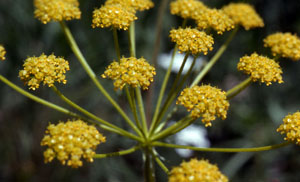
Malabaila dasyantha. Because of their characteristic inflorescences, fruits and distinctive chemistry, the family Apiaceae was one of the first to be recognized as a natural group in scientific botanical literature

The Apiaceae were also the first family of flowering plants to be monographed (1672). This is the front page of Roberto Morison's Plantarum umbelliferarum, from the University of Illinois' Rare Book Collection Library
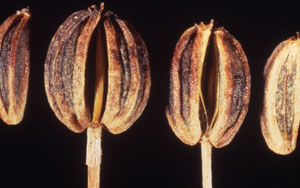
The fruit of Zizia aurea and other apioid ubellifers is a small schizocarp that splits into two mericarps. Connecting the mericarps is a persistent carpophore. Photograph taken by Ken R. Robertson
|
The 6th International Symposium on the Apiales, Moscow, Russia (June 2008)
AN ITS-BASED CLASSIFICATION OF APIACEAE SUBFAMILY APIOIDEAE
S.R. Downie, K. Spalik, D.S. Katz-Downie, and J.-P. Reduron
Slide Presentation
At present, and likely in the foreseeable future, nrDNA ITS sequences comprise the most comprehensive database for Apioideae phylogenetic study. These sequences are readily obtainable, even from old herbarium specimens, the phylogenies at low taxonomic levels are generally congruent with those inferred from chloroplast markers, and the few intra-individual polymorphisms revealed to date do not interfere with the phylogeny estimation. Phylogenetic analysis of 1240 ITS sequences of subfamily Apioideae currently available in GenBank and numerous unpublished sequences was carried out to recognize monophyletic groups that can be tested using evidence from cpDNA. Approximately half of these sequences had data for the intervening 5.8S gene region. These 1240 accessions represent 292 genera and 959 species from throughout the geographic range of the subfamily and include all tribes and major clades defined on the basis of previous molecular systematic studies except its most early diverging branches (Heteromorpheae, Annesorhiza clade, Lichtensteinia clade), basal genera of uncertain phylogenetic position (Astydamia, Choritaenia, Ezosciadium, Molopospermum), and a lineage characterized by rapid ITS sequence evolution relative to its sister group (North American Endemics clade of tribe Oenantheae). All taxa excluded from this investigation have ITS sequences that cannot be readily aligned with those of most members of the crown clades. Based on taxonomic congruence among the results of phylogenetic analyses of diverse molecular data sets (cpDNA gene and intron sequences, cpDNA restriction sites, ITS sequences), the following 10 tribes are erected or confirmed as monophyletic: Aciphylleae, Bupleureae, Careae, Coriandreae, Echinophoreae, Oenantheae, Pleurospermeae, Pyramidoptereae, Scandiceae (incl. subtribes Daucinae, Ferulinae, Scandicinae, Torilidinae, and the Glaucosciadium clade), and Smyrnieae. In addition, the results of previous and present phylogenetic analyses of only ITS sequences support four monophyletic tribes (Apieae, Selineae [incl. Arracacia, Johrenia, and Perennial Endemic North American Apioid clades], Tordylieae [incl. Cymbocarpum and African peucedanoid clades], Pimpinelleae) and the following 12 informally recognized, major clades of largely uncertain relationship (asterisks denote clades that are monogeneric): Acronema, Arcuatopterus*, Cachrys, Chamaesium*, Conioselinum, Conium*, Diplolophium*, Erigenia*, Komarovia, Opopanax, Physospermopsis (East Asia clade), Sinodielsia. Several of these clades are not well supported and intergrade in some phylogenetic analyses; however, each of the 1240 accessions examined can be unambiguously assigned to a particular tribe or major clade. Numerous genera are not monophyletic within their respective groups. Furthermore, 26 genera are assigned to two or more of the aforementioned tribes or major clades. Five of these genera (Angelica, Peucedanum, Physospermopsis, Seseli, Trachyspermum) are each assigned to three or four major lineages, and three genera (Ligusticum, Pimpinella, Pleurospermum) occur in five or six. Like the Peucedanum problem of current worldwide interest, any one of these highly polyphyletic genera can therefore be considered for further collaborative study. Misidentifications of Apioideae ITS sequences in NCBIs taxonomic database are plentiful, as are the placements of many genera in incorrect tribes or clades. Moreover, nomenclatural changes proposed in recent studies are not usually reflected in GenBank, leading to taxonomic confusion. The limitations of ITS data in resolving the higher-level phylogenetic relationships among many of these tribes and major clades are severe, particularly those of the apioid superclade. Further resolution of these relationships, as well as the possible recognition of these 12 clades at tribal levels, must await supporting data from the conservatively evolving plastid genome. A standardized system of phylogenetic classification for the subfamily is required, with sampling in future systematic studies directed by the results obtained using these ITS sequence data.
|
|
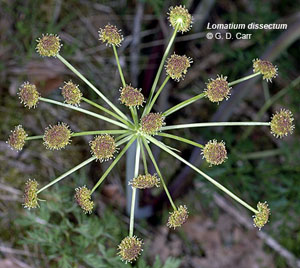
Lomatium dissectum. The Apiaceae have a cosmopolitan distribution, reaching their greatest diversity in China, Iran, Russia, and western North America (where this species is endemic). Photo by G.D. Carr
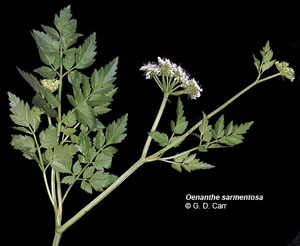
Oenanthe sarmentosa. Pacific water parsley is native to western North America. Photo by G.D. Carr
|
The 5th International Symposium on the Apiales, Vienna, Austria (July 2005)
FURTHER PHYLOGENETIC STUDIES IN APIACEAE TRIBE OENANTHEAE: GENERIC-LEVEL RELATIONSHIPS AND RESOLUTION WITHIN THE NORTH AMERICAN ENDEMICS CLADE
S.R. Downie, D. S. Katz-Downie, K. Spalik, C.-S. Lee, M.A. Feist, C. Calviņo, T. Bone, and F.-J. Sun
Slide Presentation
Previously, we presented preliminary results of phylogenetic analyses of nuclear rDNA ITS sequences to circumscribe Apiaceae tribe Oenantheae Dumort. and to reveal provisional generic-level relationships. Seventeen genera were recognized within the tribe, with four of these not monophyletic (Berula, Bifora, Cryptotaenia, and Sium). Intergeneric relationships were unresolved or only poorly supported. North American representatives of eight genera (Bifora, Cynosciadium, Daucosma, Lilaeopsis, Limnosciadium, Neogoezia, Ptilimnium, and Trepocarpus), of which six genera are endemic to the USA, comprised a strongly supported monophyletic group; however, their rapid rate of molecular evolution, paralleling their great morphological diversity (such as the rachis-leaf habit of some species in several genera), confounded interpretation of relationships. Herein, we present results of an expanded ITS investigation, as well as results obtained from phylogenetic analysis of DNA sequences from the more conservatively evolving chloroplast DNA trnQ-rps16-trnK region for approximately the same set of taxa as our previous ITS study, to gain a greater phylogenetic understanding of the tribe and insight into patterns of morphological character evolution. Greater clarification of relationships is achieved, additional genera are found to be polyphyletic, nomenclatural changes are implemented, and evidence is obtained suggesting that the rachis-leaf habit is likely a synapomorphy, uniting species from at least two genera.
|
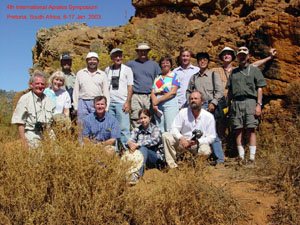
Post-conference excursion at the 4th International Apiales Symposium, South Africa. Photo by Qixin Liu

Post-conference excursion at the Cape of Good Hope, South Africa. Photo by Qixin Liu
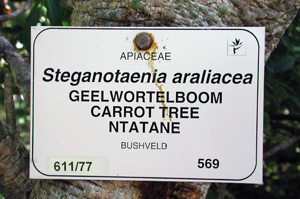
Label for "Carrot Tree," an arborescent umbellifer from Kirstenbosch National Botanic Garden, Cape Town, South Africa
|
The 4th International Symposium on the Apiales, Pretoria, South Africa (January 2003)
RELATIONSHIPS AMONG THE PERENNIAL, ENDEMIC UMBELLIFERS OF WESTERN NORTH AMERICA AS INFERRED BY PHYLOGENETIC ANALYSES OF NUCLEAR RDNA ITS SEQUENCES
S.R. Downie, F.-J. Sun, and R.L. Hartman
Slide Presentation
Considerable confusion exists with regard to the proper delimitation of and relationships among the perennial, endemic Apiaceae of western NA. Phylogenetic analyses of ITS sequences from 137 accessions (19 genera) of NA Apioideae and 22 outgroups from the Angelica clade were carried out to evaluate the monophyly of the NA endemic taxa and to ascertain the placement of Cymopterus within the group. Our results reveal that the perennial, endemic apioid umbellifers of NA comprise a weakly supported monophyletic group, with Angelica and members of the meso-American Arracacia clade constituting two of several possible sister lineages. Cymopterus and Lomatium are grossly polyphyletic, with their species inextricably linked with those of Aletes, Musineon, Oreonana, Oreoxis, Orogenia, Podistera, Pseudocymopterus, Pteryxia, and Tauschia. Lack of resolution in the ITS trees precludes unambiguous hypotheses of relationship but do show clearly that many NA genera, where resolved, are not monophyletic. Clearly, the traditional emphasis placed on fruit characters has led to highly artificial assemblages of species, and a complete reassessment of the generic limits of all of these NA taxa is in order.
|
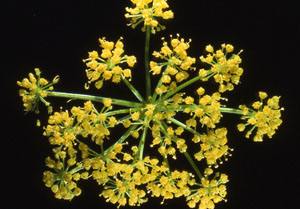
The inflorescence of Zizia aurea (golden alexander) is a compound umbel with bright yellow flowers. Photograph taken by Ken R. Robertson
|
The 3rd International Symposium on the Apiales, St. Louis, USA (August 1999)
MAJOR CLADE DELIMITATION WITHIN APIACEAE SUBFAMILY APIOIDEAE
S.R. Downie, G.M. Plunkett, M.F. Watson, D.S. Katz-Downie, K. Spalik, and B.-Y. Lee
Phylogenetic analyses of cpDNA restriction sites and chloroplast gene (rbcL, matK), intron (rpoC1, rpl16, rps16), and nuclear rDNA ITS sequences, with supplementary data from chloroplast genome structural rearrangements were used to elucidate major clades within the subfamily. Based on consensus of relationship, 12 major lineages have been inferred of which six have been treated at the tribal level: Bupleureae, Heteromorpheae, Oenantheae, Pleurospermeae, Smyrnieae, and Scandiceae. Heteromorpheae and Bupleureae constitute basal clades; the relationships among the other tribes are not clear. Tribe Scandiceae includes subtribes Scandicinae, Daucinae, and Torilidinae, with the latter two comprising taxa traditionally placed in Caucalideae.
|
|
|
|
|